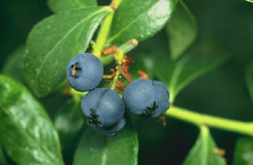This page has been archived and is being provided for reference purposes only. The page is no longer being updated, and therefore, links on the page may be invalid.
|
Presenting Prince, a New Blueberry Cultivar
By Stephanie YaoNovember 17, 2008
Agricultural Research Service (ARS) scientists have released a new early-ripening rabbiteye blueberry cultivar that, when grown with other blueberry varieties, will extend the growing and harvesting season in the U.S. Gulf Coast region.
The new variety, named Prince, was developed at the ARS Southern Horticultural Laboratory in Poplarville, Miss. and tested in Stone County and McNeil, Miss., by Stephen Stringer, a research geneticist at the Poplarville lab. Prince produced high scores when tested over three years in several categories including color, firmness, flavor and size.
The Mississippi climate—with occasional early spring frosts and excessive heat and humidity—can be brutal on blueberry farming. Princetends to have an extended bloom period, providing insurance against early spring frost. It is also more adapted to the region’s hot and humid climate than other varieties. Most notably, Prince ripens four to five days earlier than the earliest-ripening rabbiteye blueberry varieties, allowing growers to capitalize on the lucrative early-season, fresh-blueberry market period.
A cross between MS 598 and Florida 80-11, Prince blueberries are medium in size and color with a mild flavor and less tartness than many other rabbiteye varieties. The cultivar was named Prince as a result of observations by retired ARS scientist and blueberry breeder Arlen Draper, who often commented that one has to “kiss a lot of frogs before finding a prince.”
Prince is the latest blueberry variety to be released by the ARS Poplarville lab. After Hurricane Camille wiped out the region’s tung oil industry in 1969, ARS scientists looked to blueberries to help growers overcome the economic loss. Today, blueberry growers along the Gulf Coast enjoy a competitive advantage over northern growers, since they are among the first to provide fruit for the fresh blueberry market as well as for processing and juice.
A limited supply of one-year-old plants is available to nurserymen for propagation and sale to growers.
ARS is a scientific research agency of the U.S. Department of Agriculture.

